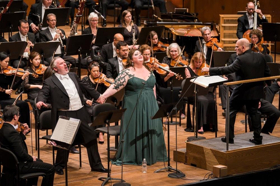Review: No 'Ho-yo-to-ho' but Van Zweden Brings God-like WALKURE to NY Phil with Melton and O'Neill

conductor van Zweden. Photo: Chris Lee
Wagner aplenty, Wagner galore.
After starting the week off with the Met's PARSIFAL under the exciting Nezet-Seguin, I ended it with another Wagner, DIE WALKURE, in a sweeping account of Act I from the New York Philharmonic under its music director designate, Jaap van Zweden.
WALKURE's Act I doesn't have the famed "Ride of the Valkyries" or Brunnhilde's ear-popping war-cry, "Ho-yo-to-ho!", but it does have one of the greatest stretches of music in Wagner's 15-hour tetralogy, DER RING DES NIBELUNGEN (often referred to as "The Ring").
And while the concert presented only this excerpt--the orchestra has special ties to it, having given the American premiere in 1876 (as the Philharmonic Society)--it was quite enough to give a taste of things to come under the new conductor: especially in his bold-face execution, sure-handed with the complex music and monumental forces on stage, and choice of soprano Heidi Melton as Sieglinde, the female half of the Ring's incestuous twins.
New Yorkers should feel lucky to have heard Melton as Sieglinde, since she seems to be tending more toward Brunnhilde these days and who knows how long she'll keep this role around. With endless, precise legato, the music poured out of her like lava from Mt. Etna, combining both beauty and stentorian sound when called upon. (I hope someone from the Met was listening.)
Dramatically, she was a perfect match with tenor Simon O'Neill's Siegmund; they acted as if they've been doing this together forever. (NB: They have recorded SIEGFRIED, the next part of the Ring, under van Zweden.) And the audience ate her up.
This was O'Neill's Philharmonic debut, but he showed off his experience with Wagner's heroics. The New Zealand heldentenor sang like there was no tomorrow: He didn't seem to stop to breathe for an instant. His voice may be a bit more nasal than some, but, frankly, the bold way he used his voice and his sure pairing with Melton made any quibbling seem petty (particularly considering the shortage of capable Wagnerian tenors these days).
Bass John Relyea was a large-voiced Hunding--the brutish husband of Sieglinde and immediate enemy of Siegmund--but he sounded somewhat wooly in his execution though it was hard to say whether he simply needed more time to warm up.
The orchestra was in fine form--including some specialists in the "Wagner tuba," a hybrid instrument--but there were definitely a few standouts: First cello Carter Brey did remarkable things with the luscious solo music Wagner wrote in the score, while Anthony McGill was a pleasure to hear on the clarinet. The Philharmonic, as a whole, seems to be embracing the new maestro's style, so different from his predecessor's.
Having premiered in 2006, it has taken a long time for John Luther Adams' Dark Waves to get to the Philharmonic, but it was worth the wait. Starting off the evening's program, it seemed just the right companion to WALKURE. With its simmering, shimmering sounds of the sea--combining electronic and orchestral textures--its rumbling, repetitive sounds gave a perfect contrast to the extreme drama that followed.
Reader Reviews
Videos

